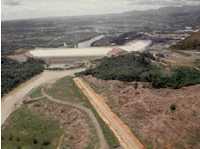The Embera Katio people fighting against the Urrá Dam Mega-Project
Embera Katío people from Alto Sinú
Por Neburuby Chamarra Panesso
http://www.noticias.nl/global_eng_artikel.php?id=290
 We are an ancient ethnic group composed at present of 2800 people. We live to the north of Colombia, in the State of Córdoba, municipality of Tierralta, between three important rivers called: Sinú (Kerado), Esmeralda (Kuranzado) and Verde (Iwagado). The land is a collective property, recognized constitutionally as Native Reserve; it means that we have the right to an extensive autonomy, and that our territory is inalienable and free of the tyranny of embargoes and prescriptions. However the Colombian government does not practice what it preaches.
We are an ancient ethnic group composed at present of 2800 people. We live to the north of Colombia, in the State of Córdoba, municipality of Tierralta, between three important rivers called: Sinú (Kerado), Esmeralda (Kuranzado) and Verde (Iwagado). The land is a collective property, recognized constitutionally as Native Reserve; it means that we have the right to an extensive autonomy, and that our territory is inalienable and free of the tyranny of embargoes and prescriptions. However the Colombian government does not practice what it preaches.
The construction of the Urrá-1 hydroelectric mega-project began in 1993, without the consent of the Embera people. 60% of its financing was from loans from Sweden, Canada and Russia. It was built for the Scandinavian company Skanska, supported by the Swedish State Agency, EKA.
The Embera population ignored the mega-project as we had never before seen a hydroelectric reservoir, and we could never have imagined such consequences. Furthermore, when we heard that the river would disappear, the elders said that it was impossible because it had been created for us by our God, Karagaby. Therefore we didn't initiate the fight of resistance until the dam was already built.
Construction of the dam has generated an irreversible impact, which has affected more than 70,000 farmer families, fishermen and indigenous Embera and Zenú:
Environmental Impact. 7,417 hectares were flooded and 21 million cubic meters of biomass were destroyed, seriously contaminating the water. Medicinal and endemic plants have disappeared. The wild fauna has gone. The extinction of 12 species of fish were made extinct by impeding their ascent for spawning. The lack of current permitted saline water to penetrate the ground, causing the general land to become salted. In summary, the ecosystem around the dam basin was severely damaged.
Social Impact. The rights of the Embera people were violated by not informing them, consulting them or asking for their consent. Both farmers and indigenous families were displaced from their homes. The division of the Embera people was caused as well as the breaking of its social framework, designed as a strategy to weaken our resistance. To defeat the fight which we are carrying out, they are using the paramilitary violence (death squads) against us, using threats, murders and abduction of our Embera leaders and authorities.
Cultural Impact. Upon flooding 417 hectares of our reserve, many sacred places (Jaidé) were buried. The disappearance of the Sinú river would lead to the loss of our traditional way of transportation: travelling by rafts. After dividing the Embera people they fought against the preservation of our culture. Many indigenous families were displaced to the city, where they are now living in misery; many are reduced to begging, delinquency, prostitution and alcoholism.
Economic Impacts. Upon disappearance of our traditional mode of transportation, we have to pay freights and passages now in vehicles for going to the city to buy what we need, or carry our products from the markets (corn, plátano, hogs). The extinction of 12 fish species, which were an essential food basis, have forced us to buy other fish at very high prices. The Tribunal Superior de Justicia de Córdoba (Córdobas' Upper Court of Justice), The Corte Suprema de Justicia (Justice Assembly), the Colombian government and also the companies have denied us help in the form of reparation damages for what we have suffered, and they also have refused to pay back the money for the changes caused in transportation and food supplies.
Impacts in the Health. Food deficiencies due to the extinction of the fish that constituted our main food source, the disappearance of many medicinal plants and the contaminated water, have brought serious unknown illnesses, causing the death of many children. Furthermore, the hydrologic reservoir brought a plague of mosquitos and other insects that have seriously affected our health.
Urrá 2 hydroelectric mega-project
After our long fight of resistance (international accusations, demonstrations, appealing to the municipal council, and a camp for more than five months in the garden of the Department of the Environment in Bogota), a breakthrough was achieved on April 19th 2000, when the Colombian government signed an agreement to stop the construction of the second phase of the dam and to guarantee our human rights that were being threatened. But nothing changed: the paramilitaries continued murdering and abducting, while all indications show that they will go ahead with phase two of the project.
Construction will mean flooding all the territory of Embera Katío and the complete extermination of our people. The present strategy of the government is focused on displacing us by the use of paramilitaries, that use the threat and implementation of incursions and massacres. We stand and we will stay standing in resistance. We do not want to disappear like a city of the ancients. We have the right to exist and to exercise our free self-determination. We need global political support to defend us from paramilitary attacks.
If you want to know more about our fight and how to help, write to us at:
karagaby@hotmail.com, karagaby226@hotmail.com and camaemka@col3.telecom.com.co
Neburuby Chamarra Panesso
Cabildo Mayor Embera-Katío del Alto Sinú
read also:
Colombian Indigenous People Killed Opposing Dam (10/2/1999)
noticias.nl | ALCA/FTAA | Plan Puebla-Panamá | Dam Protests | www.agp.org